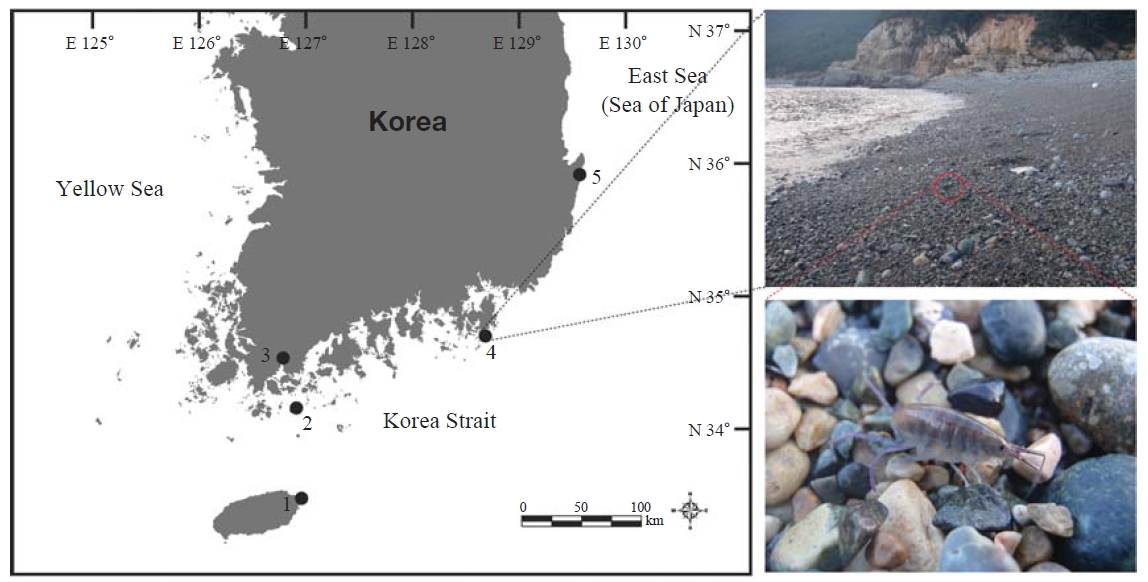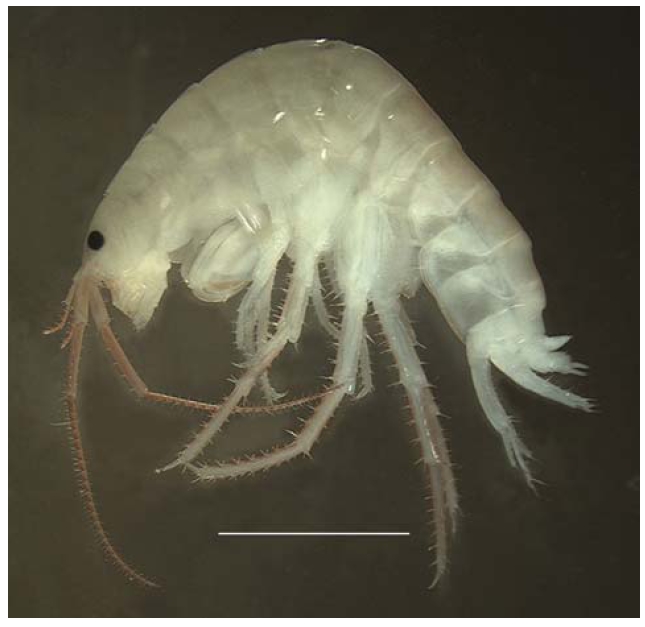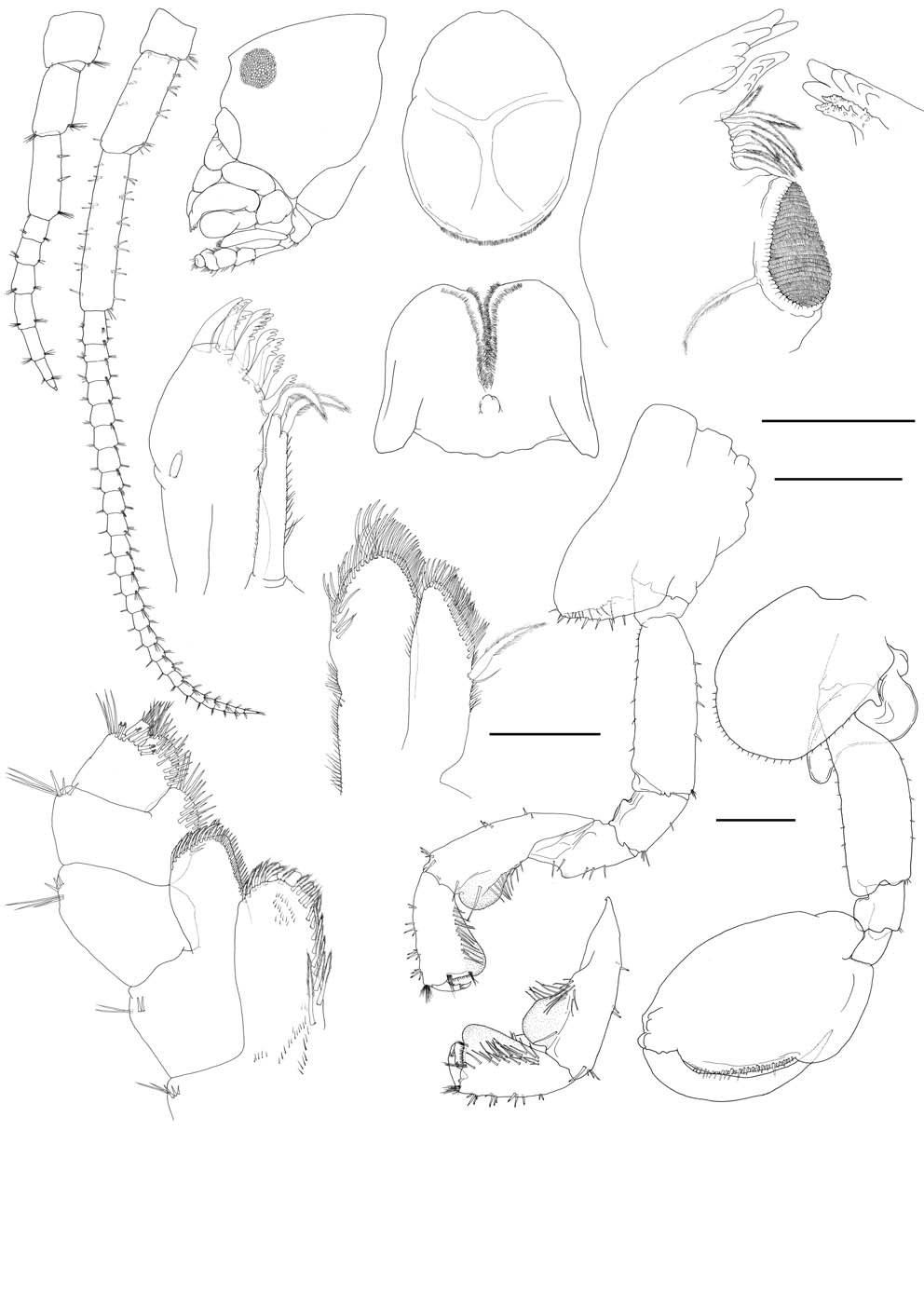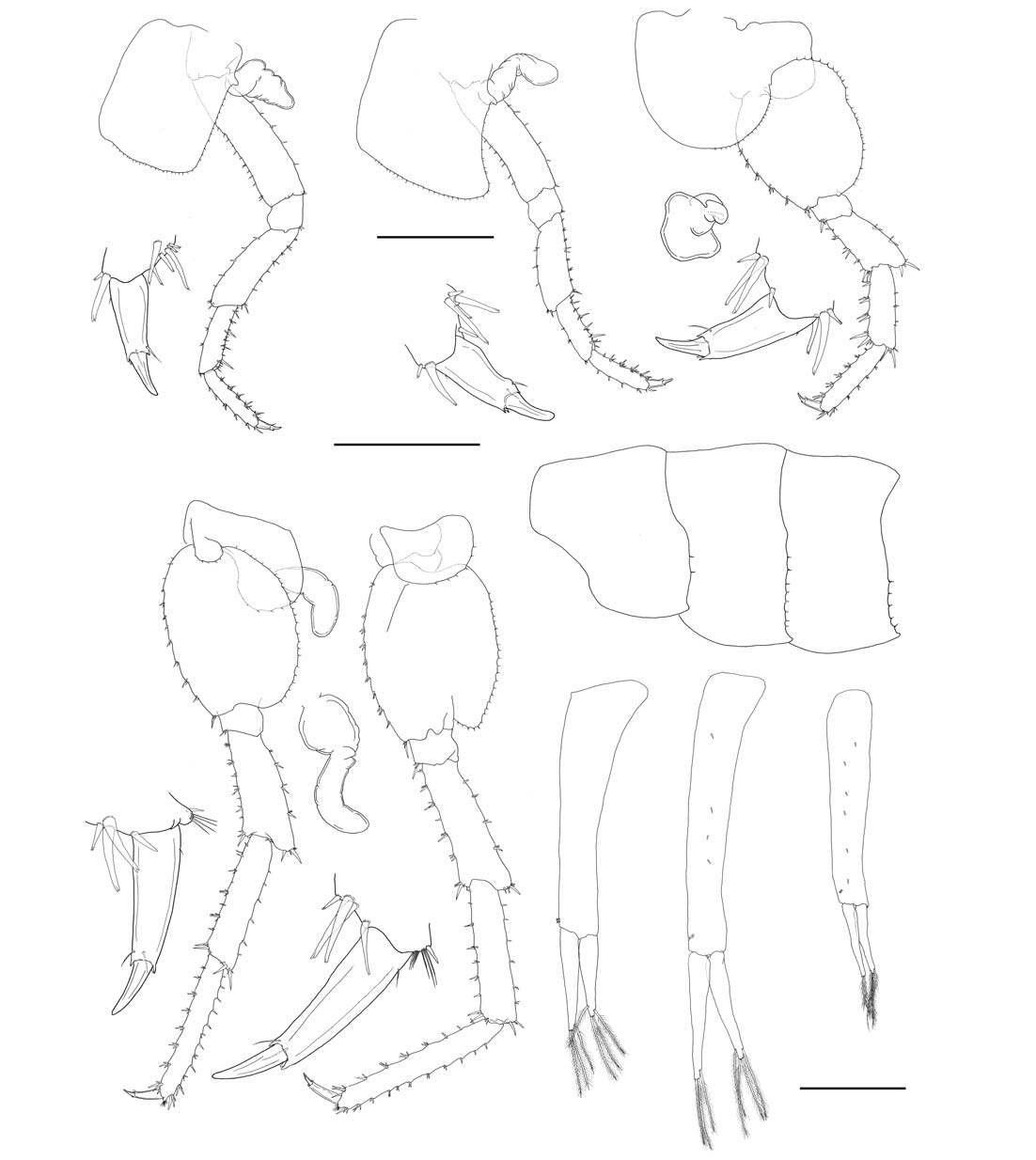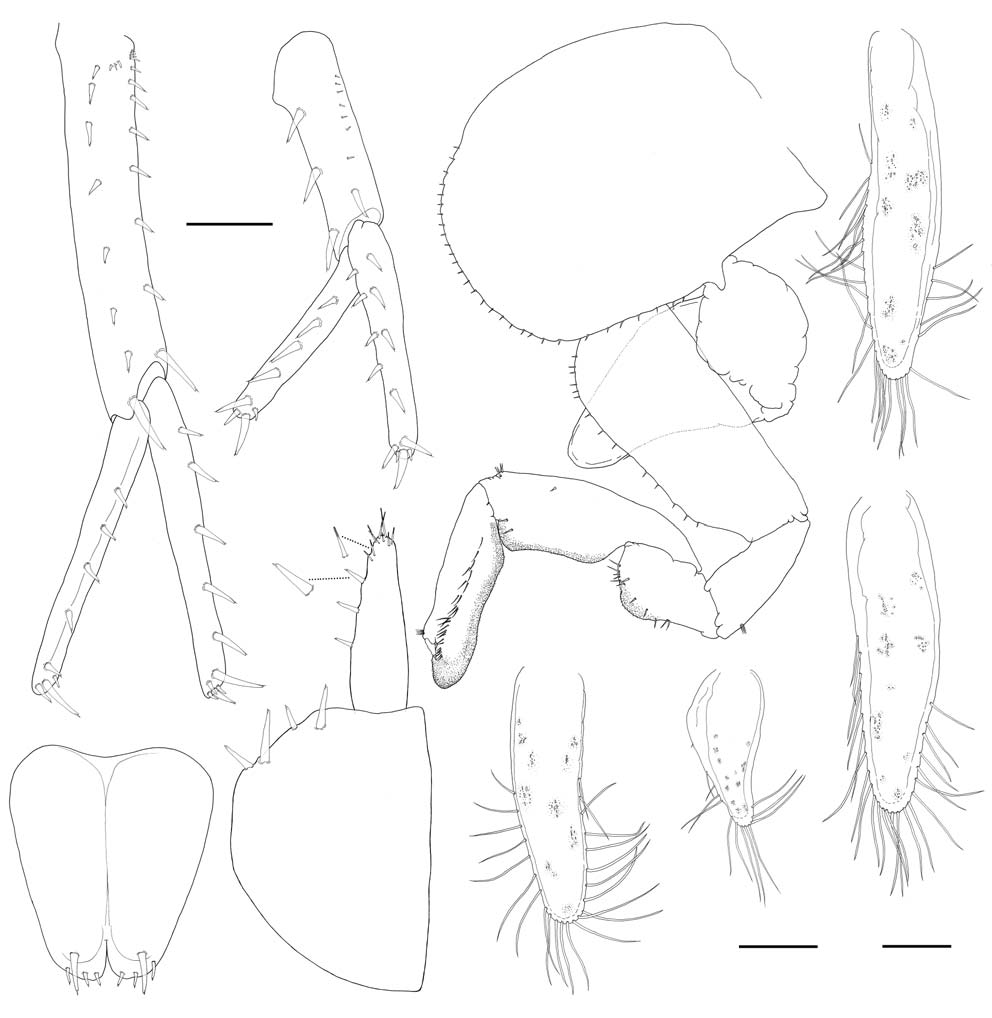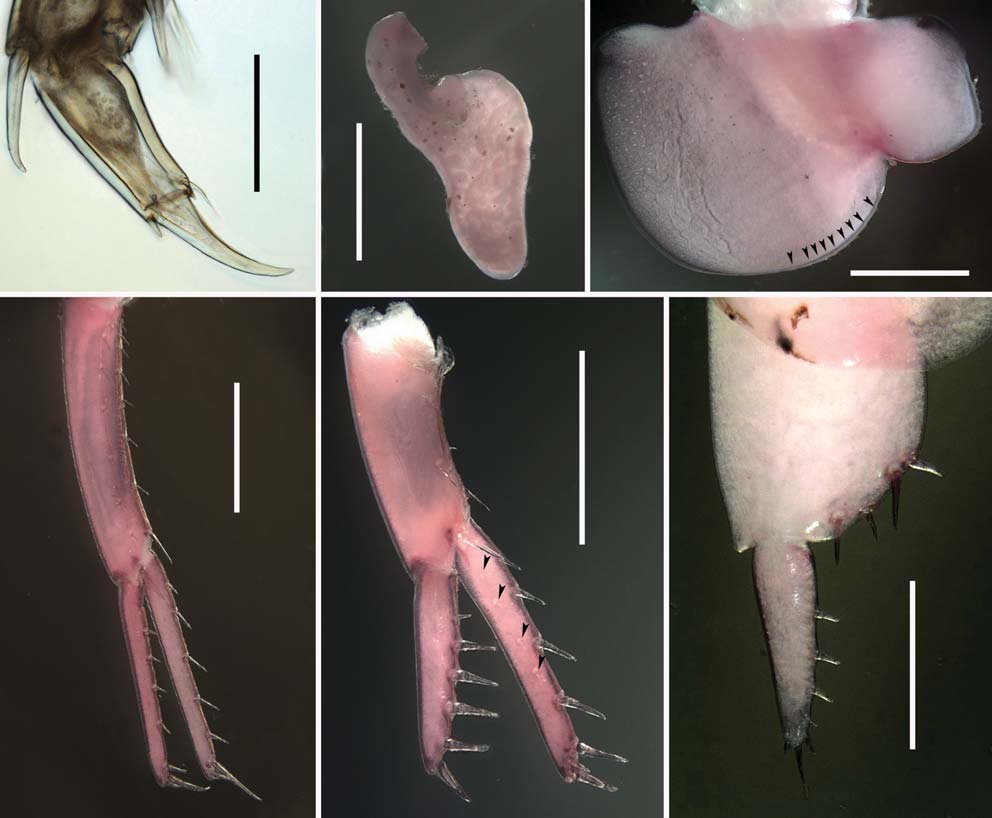



The family Talitridae Rafinesque, 1815, is the only amphipod group that adapted to terrestrial or semi-terrestrial habitats.According to Serejo and Lowry (2008), talitrids currently include approximately 250 species in 52 genera worldwide.Bousfield (1984) subdivided them into four systematic-ecological groups: palustral talitrids, beach fleas, sand hoppers,and land hoppers.
Bousfield (1982) established newly the genus
Herein, we report
From 2009-2011, talitrids were collected under rotting seaweed on a gravel beach in Korea (Fig.1 ). The collected specimens were immediately fixed on-site with 95% ethyl alcohol.The specimens were observed and dissected with tungsten needles under both a stereomicroscope (Model SZX-ILLB2-200; Olympus, Tokyo, Japan) and a light microscope (Model DM 2500; Leica, Wetzlar, Germany). All dissected appendages were mounted on glycerin and were stained with Lignin Pink. All drawings were made using a drawing tube attached to a microscope. Images were recorded using a microscope digital camera (Model Moticam 2000; Motic Incorporation Ltd., Hong Kong, China), and developed with software (Model Helicon Focus®; Helicon Soft Ltd., Kharkov, Ukraine).All specimens used in this study were deposited in the Department of Biological Sciences, Inha University, South Korea.
Order Amphipoda Latreille, 1816
Family Talitridae Raphinesque, 1815
1*Genus Paciforchestia Bousfield, 1982
Diagnosis. Antenna 2 slender and elongate, peduncle not incrassate; male gnathopod 2 with propodus oval in shape,palm smoothly oblique; pereopods 3-7 cuspidactylate; pleopods more or less reduced, pleopod 3 shortest; telson with medial suture-line on dorsal surface.
Type species.
Species composition.
1*Paciforchestia pyatakovi (Derzhavin, 1937) (Figs. 2-6)
Orchestia pyatakovi Derzhavin, 1937: 89, table 2; Gurjanova,1951: 805-806, fig. 560; Bulycheva, 1957: 172-173, fig. 62a, b; Morino, 1975: 180-184, figs. 9-11.
Orchestia tenuimana: Iwasa, 1939: 268-271, Pl. 13, figs.10, 11; Stephensen, 1944: 63-65, figs. 20, 21.
Paciforchestia tenuimana: Bousfield, 1982: 17.
Paciforchestia pyatakovi: Bousfield, 1982: 17; Miyamoto and Morino, 2010: 156-158.
Materials examined. Korea: Jeollanam-do: 4♂ and 4♀,Wando-gun, Isl. Cheongsando, Sangsanpo, 34°11′N, 126° 54′E, 1 Aug 2010, Kim MS; 4♂ and 4♀, Gangjin-gun,Janggye-ri, Chillyang, 34°32′N, 126°47′E, 18 Mar 2010, Kim MS; Jeju-si: 4♂ and 4♀, Isl. Udo, Geommeolle beach,33°29′N, 126°58′E, 8 Jan 2011, Kim MS; Gyeongsangnamdo:4°and 4♀, Geoje-si, Dapo-ri, Yeocha gravel beach, 34°42′N, 128°37′, 30 Sep 2010, Kim MS; 4♂ and 4♀, Pohang-si, Nam-gu, Guryongpo beach, 35°59′N, 129°33′E, 14 Oct 2009, Kim MS.
Description. Male: Body (Figs. 2, 3C) 19.3 mm, large and laterally compressed, usually gray or dark brown color when alive. Eyes subround and black, width 0.24 times head diameter.
Antenna 1 (Figs. 2, 3A) reaching almost midpoint of peduncular article 5 of antenna 2; peduncular articles 1-3 with length ratio of 1 : 1.26 : 1.5 respectively, with distal setae;peduncular article 3 with two minute spines; flagellum 7-articulate.
Antenna 2 (Figs. 2, 3B), 0.47 times as long as body length;
peduncular articles 4-5 with length ratio of 1 : 1.5, bearing many short spines and with distal setae; flagellum 26-articulate,2.69 times of peduncular article 5; each article with short setae distally.
Upper lip (Fig.3 D) oval in shapes, apical margin with fine setae.
Left mandible (Fig.3 E), incisor 6-dentate, lacinia mobilis with 5-weak teeth, molar triturative with one plumose seta.Right mandible (Fig.3F), incisor 6-dentate, lacinia mobilis bifurcate with many weak dentitions apically.
Lower lip (Fig.3 G) bilobed, with fine setae on apical and inner margins; inner plate small.
Maxilla 1 (Fig.3 H), inner plate with two plumose setae distally; outer plate with nine saw-like spines distally; palp minute, with two articles.
Maxilla 2 (Fig.3 I), inner plate with one large plumose seta on medial margin, bearing many blunt spines distally; outer plate with two rows of many blunt spines distally.
Maxilliped (Fig.3 J), inner plate with several plumose setae on lateral and distal margins, three tooth-like spines distally;outer plate with 12 plumose setae on distal margin and many spines on inner margin; maxillipedal palp consisting of four articles, article 2 with well-developed mediodistal lobe, article 4 reduced, with few distal spines.
Gnathopod 1 (Fig.3 K, L) subchelate; coxal plate 1 subtriangular,with many spines on posterior margin; basis straight,with nine minute spines on anterior margin and four spines on posterior margin; merus with five spines and one small tumescent hump on posterior margin; carpus with two tufts of two spines on dorsal margin, posterior margin with tumescent hump, 10 inner and nine outer spines; propodus 0.65 times as long as carpus, with four tufts of 2-4 spines on dorsal margin and tumescent hump posteriorly, lateral margin with 14 outer and 23 inner spines; dactyls subequal to palm in length, with three fine setae on inner margin and three fine setae at hinge of nail.
Gnathopod 2 (Fig.3 M) subchelate; coxal plate 2 subrounded,with many fine setae on ventral margin, posterior cusp obtuse; anterior margin of basis straight, with nine minute spines, posterior margin slightly curved, with five minute spines; propodus oval in shape, posterior margin marginally bare and palmar margin smoothly convex, fringed with many short spines; dactyls strongly curved, distal part narrowed.
Pereopods 3-4 (Figs. 4A-D, 6A) cuspidactylate; pereopod 3 slightly longer than pereopod 4; coxal plate 3 sub-rectangular,with many fine setae on ventral margin, posterior cusp obtuse; basis straight, with several minute spines on anterior and posterior margins; merus to propodus with several tufts of 1-4 spines on anterior and posterior margins; dactyls with two setae at hinge of nail; pereopod 4 resembling pereopod 3, but posterior corner of coxal plate 4 expanded and dactyls slightly thickened and pinched posteriorly.
Pereopods 5-7 (Figs. 4E, G, H, J-L, 6C) cuspidactylate,with length ratio of 1 : 1.34 : 1.52 respectively; coxal plate 5-6 bilobate, anterior lobe of coxal plate 5 larger than posterior one, posterior margin with several fine setae, while anterior lobe of coxal plate 6 very small, both anterior and posterior lobes with several fine setae on ventral margin; coxal plate 7 non-lobate, with six fine setae on posterior margin;basis of pereopod 5 round in shape, posterior margin slightly expended, while basis of pereopods 6-7 oval in shape,basis of pereopods 5-7 with several fine setae on posterior margin, anterior margin with short spines; merus to dactyls resembling pereopod 3.
Gills 2-6 (Figs. 3M, 4A, C, F, I, 6B) present; gill 2 elongated,broad and curved in middle; gills 3-4 similar in resemblance;gill 5 broader than gills 3-4, twisted; gill 6 longest,narrowing distally.
Epimeral plates 1-3 (Fig.4 M) with weakly pointed posterior angles, ventral margin marginally bare and posterior margin with several fine setae.
Pleopods 1-3 (Fig.4 N-P) degraded, with length ratio of 1 :1.13 : 0.79, respectively, peduncles of pleopods with two retinaculae distally, both rami with single article, bearing 2-4 plumose setae distally; peduncle of pleopod 1 marginally bare, while peduncles of pleopods 2-3 with 4-6 minute spines on surface.
Uropod 1 (Figs. 5A, 6D), peduncle with two rows of 7-10 marginal spines and strong distolateral spines; outer ramus about 0.77 times of peduncle, with four marginal and four distal spines, inner ramus with five marginal and five distal spines.
Uropod 2 (Figs. 5B, 6E), peduncle with three spines on outer margin, inner margin with one spine and seven minute spines; outer ramus with four marginal and four distal spines,inner ramus with four, four, and five spines on inner, outer and distal margins respectively.
Uropod 3 (Figs. 5C, 6F), peduncle broadened dorsally,with four dorsal spines; ramus slightly shorter than peduncle,with three strong marginal spines and group of two long spines and seven short spines distally.
Telson (Fig.5 D) sutriangular in shape, distally notched,with medial suture-line on dorsal surface; each lobe with four apical spines.
Female: Body 19.8 mm. General appearance resembling male, with the following differences:
Gnathopod 2 (Fig.5 E), basis anterior margin expanded, with 15 minute spines, posterior margin straight and marginally bare; merus, carpus and propodus tumescent posteriorly,with 12 short spines, two spines and 27 spines on posterior,posterodistal and lateral margins respectively.
Oostegites 2-4 (Fig.5 E-I) elongate, parallel-sided, with 23-28 bristles; oostegite 5 triangular in shape, with 12 bristles on distal margin.
Habitat.This species lives in the gaps between pebbles on gravel beaches. They were usually found under rotting seaweed on the gravel beach.
Remarks. Derzhavin (1937) first reported
In general, Korean
Korean name: 1*아시아도약옆새우속 (신칭) Korean name: 1*아시아도약옆새우 (신칭)
